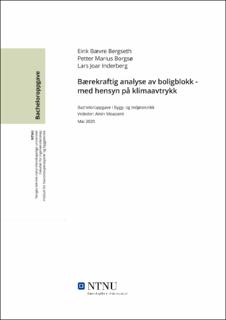| dc.contributor.advisor | Moazami, Amin | |
| dc.contributor.author | Bævre Bergseth, Eirik | |
| dc.contributor.author | Borgsø, Petter Marius | |
| dc.contributor.author | Inderberg, Lars Joar | |
| dc.date.accessioned | 2020-07-07T16:05:07Z | |
| dc.date.available | 2020-07-07T16:05:07Z | |
| dc.date.issued | 2020 | |
| dc.identifier.uri | https://hdl.handle.net/11250/2661154 | |
| dc.description.abstract | Denne oppgaven skal ta for seg en bærekraftig analyse av en boligblokk, med hensyn på klimaavtrykk. Boligblokken oppgaven omhandler ligger i Molde. Den eksisterende løsningen i betong stod klar allerede i 2018. Oppgaven har som hensikt å sammenligne bæresystemet i den eksisterende løsningen med en ny løsning i massivtre. Hovedfokuset vil være å gjøre en livssyklusanalyse for de to materialvalgene. I tillegg tar oppgaven for seg dimensjoneringen av den nye løsningen i massivtre.
Teorien er hentet fra litteraturstudier og Sintef Byggforsk. Det er blitt brukt ulike bøker og kompendier og Norsk Standard for lastberegning. Lastberegningene er gjort for hånd og dimensjoneringen av den nye løsningen i massivtre ble gjort i beregningsprogrammet Calculatis for å kontrollere spenn og dimensjoner på vegger, søyler, bjelker og etasjeskillere.
Deretter har begge løsningene blitt modellert i Revit. Ved hjelp av modellene får man ut mengder av de ulike materialene som kan eksporteres til verktøyet for livssyklusanalyse, OneClick LCA. I klimagassregnskapet er det tatt hensyn til produksjon og transport av materialer, riving og avfallsbehandling ved livsløpets slutt.
Ut ifra klimagassregnskapet, ser vi at massivtre har store miljømessige kvaliteter i forhold til betong. Den er i tillegg fornybar. Det som hindrer den store utviklingen, er hovedsakelig tilgjengelighet og kostnad. Både i form av materialpriser og ekstrakostnader på grunn av manglende kunnskap i prosjekteringen. | |
| dc.description.abstract | This thesis will address a sustainable analysis of an apartment building, regarding carbon footprint. The apartment block is in Molde, Norway. The existing concrete solution was ready as early as 2018. The task is intended to compare the structural system of the existing solution with a new solution in solid wood. The focus will be to do a lifecycle analysis for the two material choices. In addition, the task deals with the structural design of the new solution in solid wood.
The theory is taken from literature studies and Sintef Byggforsk. Various books and compendia and the Norwegian Standard have been used for the load calculation. The load calculations are done by hand and the dimensioning of the new solution in solid wood was made in the calculation program Calculatis to control the spans and dimensions of walls, pillars, beams and floors.
Then both solutions have been modeled in Revit. The models bring out quantities of the various materials that can be exported to the LifeCycle Analysis Tool, OneClick LCA. In the greenhouse gas accounts, production and transport of materials, demolition and waste treatment is considered at the end of the life cycle.
Based on the greenhouse gas accounts, we see that solid wood has great environmental qualities compared to concrete. It is also renewable. What prevents the major development is mainly availability and cost. Both in terms of material prices and additional costs due to lack of knowledge in the design. | |
| dc.publisher | NTNU | |
| dc.title | Bærekraftig analyse av boligblokk - med
hensyn på klimaavtrykk | |
| dc.type | Bachelor thesis | |
